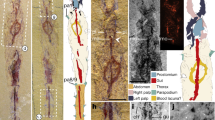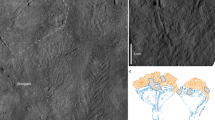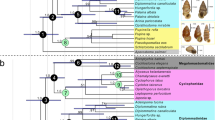Abstract
Crown-group crustaceans (Eucrustacea) are common in the fossil record of the past 500 million years back to the early Ordovician period, and very rare representatives are also known from the late Middle and Late Cambrian periods1. Finds in Lower Cambrian rocks of the Phosphatocopina, the fossil sister group to eucrustaceans2, imply that members of the eucrustacean stem lineage co-occurred, but it remained unclear whether crown-group members were also present at that time. ‘Orsten’-type fossils are typically tiny embryos and cuticle-bearing animals, of which the cuticle is phosphatized and the material is three-dimensional and complete with soft parts. Such fossils are found predominantly in the Cambrian and Ordovician and provide detailed morphological and phylogenetic information on the early evolution of metazoans. Here we report an Orsten-type Konservat-Lagerstätte from the Lower Cambrian of China that contains at least three new arthropod species, of which we describe the most abundant form on the basis of exceptionally well preserved material of several growth stages. The limb morphology and other details of this new species are markedly similar to those of living cephalocarids, branchiopods and copepods and it is assigned to the Eucrustacea, thus representing the first undoubted crown-group crustacean from the early Cambrian. Its stratigraphical position provides substantial support to the proposition that the main cladogenic event that gave rise to the Arthropoda was before the Cambrian3. Small leaf-shaped structures on the outer limb base of the new species provide evidence on the long-debated issue of the origin of epipodites4,5: they occur in a set of three, derive from setae and are a ground-pattern feature of Eucrustacea.
This is a preview of subscription content, access via your institution
Access options
Subscribe to this journal
Receive 51 print issues and online access
$199.00 per year
only $3.90 per issue
Buy this article
- Purchase on Springer Link
- Instant access to full article PDF
Prices may be subject to local taxes which are calculated during checkout



Similar content being viewed by others
References
Waloszek, D. in The New Panorama of Animal Evolution (eds Legakis, A., Sfenthourakis, S., Polymeni, R. & Thessalou-Legaki, M.) 69–87 (Pensoft, Sofia-Moscow, 2003)
Siveter, D. J., Waloszek, D. & Williams, M. An early Cambrian phosphatocopid crustacean with three-dimensionally preserved soft parts from Shropshire, England. Spec. Pap. Palaeont. 70, 9–30 (2003)
Peterson, K. J., McPeek, M. A. & Evans, D. A. Tempo and mode of early animal evolution: inferences from rocks, Hox, and molecular clocks. Paleobiology 31 (suppl.). 36–55 (2005)
Lauterbach, K. Über die mutmaßliche Herkunft der Epipodite der Crustacea. Zool. Anz. 202, 33–50 (1979)
Hessler, R. R. Reflections on the phylogenetic position of the Cephalocarida. Acta Zool. 73, 315–316 (1992)
Hou, X.-G. et al. The Cambrian Fossils of Chengjiang, China: the Flowering of Early Animal Life (Blackwell, Oxford, 2004)
Luo, H.-L. et al. The Sinian–Cambrian Boundary in Eastern Yunnan, China (Yunnan People’s Publishing, Kunming, 1982)
Hou, X.-G., Siveter, D. J., Williams, M. & Feng, X.-H. A monograph of Bradoriid arthropods from the Lower Cambrian of southwest China. Trans. R. Soc. Edinb. Earth Sci. 92, 347–409 (2002)
Chen, J.-Y., Vannier, J. & Huang, D.-Y. The origin of crustaceans: new evidence from the Early Cambrian of China. Proc. R. Soc. Lond. B 268, 2181–2187 (2001)
Babbitt, C. C. & Patel, N. H. in Crustacea and Arthropod Relationships Vol. 16 (eds Koenemann, S. & Jenner, R. A.) 275–294 (Taylor & Francis, Boca Raton, 2005)
Fanenbruck, M. & Harzsch, S. A brain atlas of Godzilliognomus frondosus Yager, 1989 (Remipedia, Godzilliidae) and comparison with the brain of Speleonectes tulumensis Yager, 1987 (Remipedia, Speleonectidae): implications for arthropod relationships. Arth. Struc. Dev. 34, 343–378 (2005)
Giribet, G., Richter, S., Edgecombe, G. D. & Wheeler, W. C. in Crustacea and Arthropod Relationships Vol. 16 (eds Koenemann, S. & Jenner, R. A.) 307–352 (Taylor & Francis, Boca Raton, 2005)
Glenner, H., Thomsen, P. F., Hebsgaard, M. B., Sørensen, M. V. & Willerslev, E. The origin of insects. Science 314, 1883–1884 (2006)
Wolff, C. &. Scholtz, G. Cell lineage analysis of the mandibular segment of the amphipod Orchestia cavimana reveals that the crustacean paragnaths are sternal outgrowths and not limbs. Front. Zool. 3, 1–14 (2006)
Carapelli, A. et al. in Crustacea and Arthropod Relationships Vol. 16 (eds Koenemann, S. & Jenner, R. A.) 295–306 (Taylor & Francis, Boca Raton, 2005)
Walossek, D. The Upper Cambrian Rehbachiella and the phylogeny of Branchiopoda and Crustacea. Foss. Strat. 32, 1–202 (1993)
Olesen, J. in Evolutionary Developmental Biology of Crustacea Vol. 15 (ed. Scholtz, G.) 217–269 (Lisse, Balkema, 2004)
Schram, F. R. & Koenemann, S. Developmental genetics and arthropod evolution: part I, on legs. Evol. Dev. 3, 343–354 (2001)
Sanders, H. L. The Cephalocarida. Functional morphology, larval development, comparative external anatomy. Mem. Conn. Acad. Arts Sci. 15, 1–80 (1963)
Maas, A., Waloszek, D. & Müller, K. J. Morphology, ontogeny and phylogeny of the Phosphatocopina (Crustacea) from the Upper Cambrian “Orsten” of Sweden. Foss. Strat. 49, 1–238 (2003)
Walossek, D. & Müller, K. J. Stem-lineage crustaceans from the Upper Cambrian of Sweden and their bearing upon the position of Agnostus . Lethaia 23, 409–427 (1990)
Cannon, H. G. & Leak, F. M. C. On the feeding mechanism of the Branchiopoda. Phil. Trans. R. Soc. Lond. B 222, 267–352 (1933)
Barlow, D. I. & Sleigh, M. A. in The Brine Shrimp Artemia, 1, Morphology, Genetics, Radiobiology, Toxicology (eds Persoone, G., Sorgeloos, P., Roels, O. & Jaspers, E.) 61–73 (Universa, Wetteren, 1980)
Cannon, H. G. On the feeding mechanism of Nebalia bipes . Trans. R. Soc. Edinb. 55, 355–369 (1927)
Cannon, H. G. Nebaliacea. Discov. Rep. 3, 199–222 (1931)
Hamner, W. M. Biomechanics of filter feeding in the Antarctic krill Euphausia superba: review of past work and new observations. J. Crust . Biol. 8, 149–163 (1988)
Yager, J. Remipedia, a new class of Crustacea from a marine cave in the Bahamas. J. Crust . Biol. 1, 328–333 (1981)
Burnett, B. R. & Hessler, R. R. Thoracic epipodites in the Stomatopoda (Crustacea): a phylogenetic consideration. J. Zool. 169, 381–392 (1973)
Averof, M. & Cohen, S. M. Evolutionary origin of insect wings from ancestral gills. Nature 385, 627–630 (1997)
Boxshall, G. A. The evolution of arthropod limbs. Biol. Rev. 79, 253–300 (2004)
Acknowledgements
This work was supported by the Natural Science Foundation of China, the Ministry of Science and Technology of China, the Royal Society and the German Research Council.
Author information
Authors and Affiliations
Corresponding author
Ethics declarations
Competing interests
The authors declare no competing financial interests.
Supplementary information
Supplementary Information
The file contains Supplementary Notes and additional references. The Supplementary Notes provide plainer and more detailed data about the stratigraphy of the Lower Cambrian strata that yielded the Orsten type preservation and the phylogeny of the initial crustacean. (PDF 71 kb)
Rights and permissions
About this article
Cite this article
Zhang, Xg., Siveter, D., Waloszek, D. et al. An epipodite-bearing crown-group crustacean from the Lower Cambrian. Nature 449, 595–598 (2007). https://doi.org/10.1038/nature06138
Received:
Accepted:
Published:
Issue Date:
DOI: https://doi.org/10.1038/nature06138
This article is cited by
-
Evolution of sex determination in crustaceans
Marine Life Science & Technology (2023)
-
Functional importance of the mandibular skeleto-muscular system in the bivalved arthropod Heterocypris incongruens (Crustacea, Ostracoda, Cyprididae)
The Science of Nature (2022)
-
Exites in Cambrian arthropods and homology of arthropod limb branches
Nature Communications (2021)
-
Adrift across tectonic plates: molecular phylogenetics supports the ancient Laurasian origin of old limnic crangonyctid amphipods
Organisms Diversity & Evolution (2019)
-
Early Cambrian fuxianhuiids from China reveal origin of the gnathobasic protopodite in euarthropods
Nature Communications (2018)
Comments
By submitting a comment you agree to abide by our Terms and Community Guidelines. If you find something abusive or that does not comply with our terms or guidelines please flag it as inappropriate.



